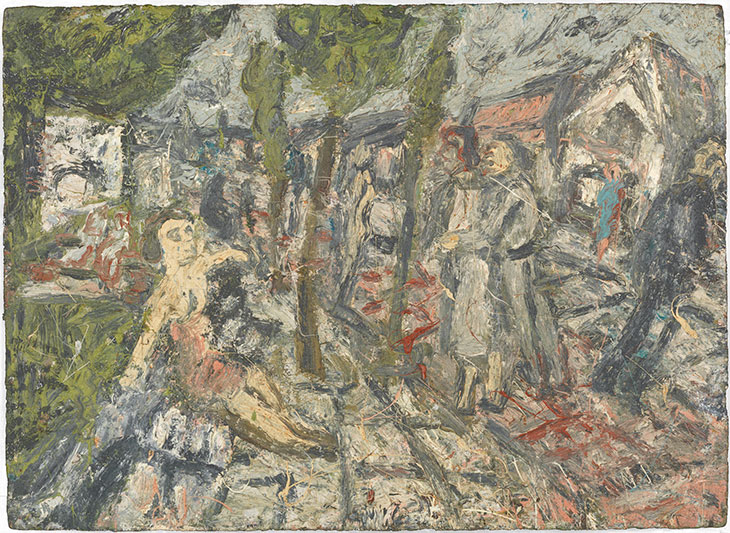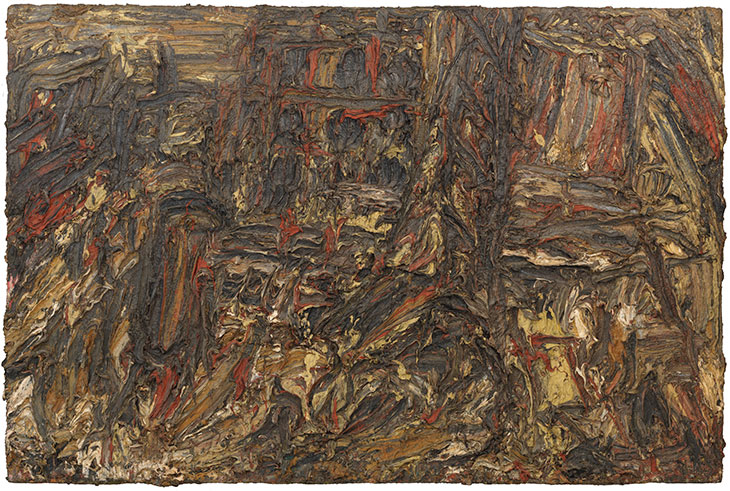I first met Leon Kossoff (1926–2019) in 1976 when I was beginning my postgraduate studies in postwar British painting. I’d already enjoyed meeting and interviewing several key figures from that time; what better approach, after all, than to go straight to the original sources for my information and ideas? So that summer, having made an appointment, I got off the tube at Willesden Green and arrived at the ordinary-looking suburban house where Leon lived and worked. During the next hour or so, he scared the life out of me. I remember escaping back into the street with scrawled notes of our conversation stuffed into my bag, having learnt that working directly with living artists might not be so simple after all. After our initial meeting, Leon was very helpful to me in my student studies but I quickly gathered that he was not comfortable talking about the ideas behind his art – and certainly quite hostile to any conflating of his biography with his work.

A Street in Willesden, Early Summer 1983 (1983), Leon Kossoff. Photo: courtesy Annely Juda Fine Art, London; © the Leon Kossoff Estate
Leon Kossoff loved London. Aged 13 when the Second World War broke out, he was evacuated to Norfolk and although the family with whom he was living showed him much kindness, even buying him his first paint box, it was in London that he belonged. After military service from 1945–48, he studied at Saint Martin’s School of Art and then the Royal College of Art but he found his true direction by attending David Bomberg’s now-legendary classes at the Borough Polytechnic. Bomberg had been pretty much rejected by the British art establishment and his teaching was about as different as possible from the conventional art school classes of the time. For the young Kossoff, Bomberg’s single-minded determination in pursuit of what he called ‘the spirit in the mass’ struck a deep chord.
His first studio was just off Mornington Crescent, then he moved to Bethnal Green before finally settling in Willesden. These locations provided him with ample subject matter, both on the streets and in his studio, where a small circle of sitters would model for him. He would frequently venture further afield, to work from Hawksmoor’s great structure, Christ Church Spitalfields, or to Arnold Circus in the East End, places that were deeply woven into the history of his family, which had settled in that part of London as part of the early 20th-century Jewish diaspora. However, any attempt to connect Leon’s childhood memories with the locations he chose to paint would be uncompromisingly dismissed as ‘fiction’.

Shell Building Site (1962), Leon Kossoff. Photo: courtesy Annely Juda Fine Art, London; © the Leon Kossoff Estate
In 1981 I joined the National Gallery as a junior member of the education department and I would often encounter him in the cafe. We’d sit and chat about our artist heroes before he would once more go into the galleries with his drawing board to work from those masterpieces that he loved so much. In the 1980s he made a wonderful series of shimmering paintings responding to Poussin’s Cephalus and Aurora and, following his successful showing at the Venice Biennale in 1995, the National Gallery invited him to exhibit there. We thought that his Poussin paintings would make a beautiful centrepiece to an exhibition but he declined. I said that if he changed his mind, he should let me know.
Ten years later, the phone rang: ‘Colin, it’s Leon. I’ve changed my mind.’ The next day I visited the studio and Leon showed me piles of drawings and prints, hundreds if not thousands, based on a small range of paintings in the gallery’s collection. He’d been making them since the late ’40s. Veronese, Poussin, Rubens, Rembrandt and Constable were top of his league and he’d return to them again and again. ‘The more I look at them and the more I work from them, the more mysterious they become,’ he would often say.
Leon Kossoff became one of that small band of artists given the privilege of out-of-hours access to the National Gallery, which was important for him because more than once he’d been asked to leave by a concerned attendant who, when the artist was working in drypoint on large zinc plates, became worried at the sight of an agitated-looking visitor getting dangerously near the paintings while clutching in his fist a sharp metal spike. He would call me the day before and I would arrange for him to be escorted to whichever room he requested, so he could be left in privacy to work. He would arrive at about seven in the morning, saying that he had got used to being an early riser from childhood because his father ran the family bakery in the East End.
His drawing in the National Gallery began when he was a student and his motivation was always to learn. This continued until he was well into his eighties. Then, one morning a letter arrived on my desk, addressed in Leon’s familiar hand. He sent his thanks for the all the help in arranging his early morning visits but he was now finishing with them. ‘I won’t trouble you again,’ he wrote. ‘My student days are finally over.’ A couple of weeks later, another phone call. ‘Sorry Colin, I was wrong. I will need to come in again, after all. There’s more to learn. I need to draw in the Rubens room.’

Children’s Swimming Pool, 11 o’clock Saturday Morning, August 1969 (1969), Leon Kossoff. Photo: courtesy the Lewis Collection; © the Leon Kossoff Estate
The National Gallery exhibition of 2007 was a splendid occasion. One of his great Christ Church Spitalfields paintings was the centrepiece, surrounded by a whole flurry of works on paper after the masters, which had all been made directly in front of the originals. The room was alive with a glorious dazzling light. There is a clichéd idea about Leon’s work that it is about the austerity and drabness of the urban landscape, filled with the gloomy despair of ’the human condition’. Perhaps this might have been partly true of his earlier work but as he matured these qualities were replaced with energy, light, life and love. His work was animated by a joie de vivre, whether he was painting King’s Cross, Kilburn Underground Station or the municipal swimming baths that have become one of his most celebrated motifs.
In 2014, Leon came in early one morning to see the National Gallery’s Veronese exhibition. He was 88 years old at the time and, despite mobility problems at that age, he was bouncing around these great and glorious pictures. He looked at me and beamed. Then, after a pause, he laughed. ‘These pictures make me feel positively middle-aged again!’
Colin Wiggins retired as Special Projects Curator at the National Gallery in London in 2016. In 2007 he curated the National Gallery exhibition ‘Leon Kossoff: Drawing from Painting’.

‘It was in London that he belonged’ – remembering Leon Kossoff
Leon Kossoff. Photo: © Toby Glanville; courtesy Annely Juda
Share
I first met Leon Kossoff (1926–2019) in 1976 when I was beginning my postgraduate studies in postwar British painting. I’d already enjoyed meeting and interviewing several key figures from that time; what better approach, after all, than to go straight to the original sources for my information and ideas? So that summer, having made an appointment, I got off the tube at Willesden Green and arrived at the ordinary-looking suburban house where Leon lived and worked. During the next hour or so, he scared the life out of me. I remember escaping back into the street with scrawled notes of our conversation stuffed into my bag, having learnt that working directly with living artists might not be so simple after all. After our initial meeting, Leon was very helpful to me in my student studies but I quickly gathered that he was not comfortable talking about the ideas behind his art – and certainly quite hostile to any conflating of his biography with his work.
A Street in Willesden, Early Summer 1983 (1983), Leon Kossoff. Photo: courtesy Annely Juda Fine Art, London; © the Leon Kossoff Estate
Leon Kossoff loved London. Aged 13 when the Second World War broke out, he was evacuated to Norfolk and although the family with whom he was living showed him much kindness, even buying him his first paint box, it was in London that he belonged. After military service from 1945–48, he studied at Saint Martin’s School of Art and then the Royal College of Art but he found his true direction by attending David Bomberg’s now-legendary classes at the Borough Polytechnic. Bomberg had been pretty much rejected by the British art establishment and his teaching was about as different as possible from the conventional art school classes of the time. For the young Kossoff, Bomberg’s single-minded determination in pursuit of what he called ‘the spirit in the mass’ struck a deep chord.
His first studio was just off Mornington Crescent, then he moved to Bethnal Green before finally settling in Willesden. These locations provided him with ample subject matter, both on the streets and in his studio, where a small circle of sitters would model for him. He would frequently venture further afield, to work from Hawksmoor’s great structure, Christ Church Spitalfields, or to Arnold Circus in the East End, places that were deeply woven into the history of his family, which had settled in that part of London as part of the early 20th-century Jewish diaspora. However, any attempt to connect Leon’s childhood memories with the locations he chose to paint would be uncompromisingly dismissed as ‘fiction’.
Shell Building Site (1962), Leon Kossoff. Photo: courtesy Annely Juda Fine Art, London; © the Leon Kossoff Estate
In 1981 I joined the National Gallery as a junior member of the education department and I would often encounter him in the cafe. We’d sit and chat about our artist heroes before he would once more go into the galleries with his drawing board to work from those masterpieces that he loved so much. In the 1980s he made a wonderful series of shimmering paintings responding to Poussin’s Cephalus and Aurora and, following his successful showing at the Venice Biennale in 1995, the National Gallery invited him to exhibit there. We thought that his Poussin paintings would make a beautiful centrepiece to an exhibition but he declined. I said that if he changed his mind, he should let me know.
Ten years later, the phone rang: ‘Colin, it’s Leon. I’ve changed my mind.’ The next day I visited the studio and Leon showed me piles of drawings and prints, hundreds if not thousands, based on a small range of paintings in the gallery’s collection. He’d been making them since the late ’40s. Veronese, Poussin, Rubens, Rembrandt and Constable were top of his league and he’d return to them again and again. ‘The more I look at them and the more I work from them, the more mysterious they become,’ he would often say.
Leon Kossoff became one of that small band of artists given the privilege of out-of-hours access to the National Gallery, which was important for him because more than once he’d been asked to leave by a concerned attendant who, when the artist was working in drypoint on large zinc plates, became worried at the sight of an agitated-looking visitor getting dangerously near the paintings while clutching in his fist a sharp metal spike. He would call me the day before and I would arrange for him to be escorted to whichever room he requested, so he could be left in privacy to work. He would arrive at about seven in the morning, saying that he had got used to being an early riser from childhood because his father ran the family bakery in the East End.
His drawing in the National Gallery began when he was a student and his motivation was always to learn. This continued until he was well into his eighties. Then, one morning a letter arrived on my desk, addressed in Leon’s familiar hand. He sent his thanks for the all the help in arranging his early morning visits but he was now finishing with them. ‘I won’t trouble you again,’ he wrote. ‘My student days are finally over.’ A couple of weeks later, another phone call. ‘Sorry Colin, I was wrong. I will need to come in again, after all. There’s more to learn. I need to draw in the Rubens room.’
Children’s Swimming Pool, 11 o’clock Saturday Morning, August 1969 (1969), Leon Kossoff. Photo: courtesy the Lewis Collection; © the Leon Kossoff Estate
The National Gallery exhibition of 2007 was a splendid occasion. One of his great Christ Church Spitalfields paintings was the centrepiece, surrounded by a whole flurry of works on paper after the masters, which had all been made directly in front of the originals. The room was alive with a glorious dazzling light. There is a clichéd idea about Leon’s work that it is about the austerity and drabness of the urban landscape, filled with the gloomy despair of ’the human condition’. Perhaps this might have been partly true of his earlier work but as he matured these qualities were replaced with energy, light, life and love. His work was animated by a joie de vivre, whether he was painting King’s Cross, Kilburn Underground Station or the municipal swimming baths that have become one of his most celebrated motifs.
In 2014, Leon came in early one morning to see the National Gallery’s Veronese exhibition. He was 88 years old at the time and, despite mobility problems at that age, he was bouncing around these great and glorious pictures. He looked at me and beamed. Then, after a pause, he laughed. ‘These pictures make me feel positively middle-aged again!’
Colin Wiggins retired as Special Projects Curator at the National Gallery in London in 2016. In 2007 he curated the National Gallery exhibition ‘Leon Kossoff: Drawing from Painting’.
Unlimited access from just $16 every 3 months
Subscribe to get unlimited and exclusive access to the top art stories, interviews and exhibition reviews.
Share
Recommended for you
The sitting targets of Lucian Freud
In his unsparing portraits, Freud pursued his mission to describe things exactly as they are
Harold Gilman cuts a dash
In praise of the Camden Town painter’s bold brushwork and daring draughtsmanship
Lino sheets and London streets – the pioneers of modern British printmaking
For a brief period between the wars, the Grosvenor School in Pimlico was the site of a printmaking revolution